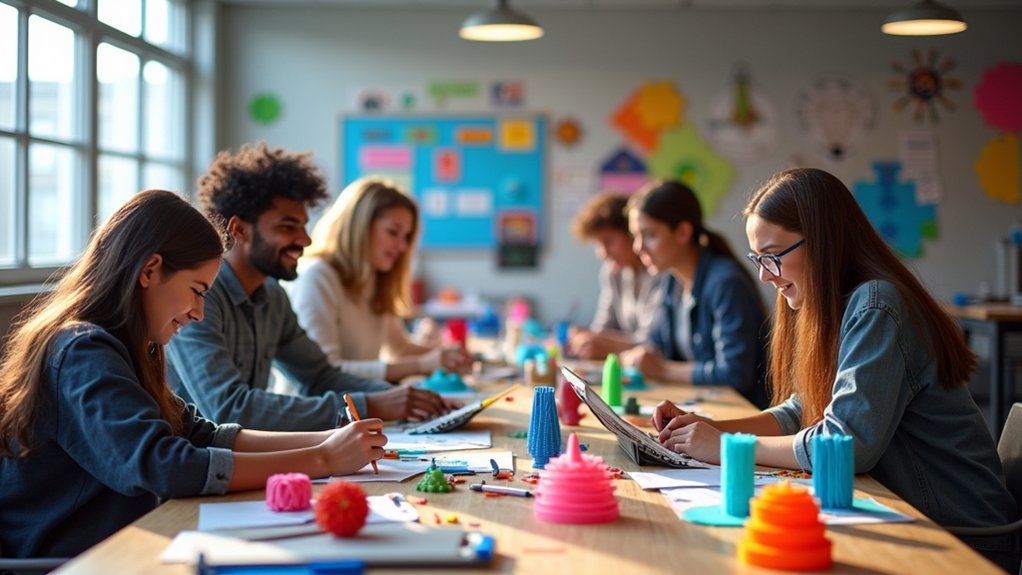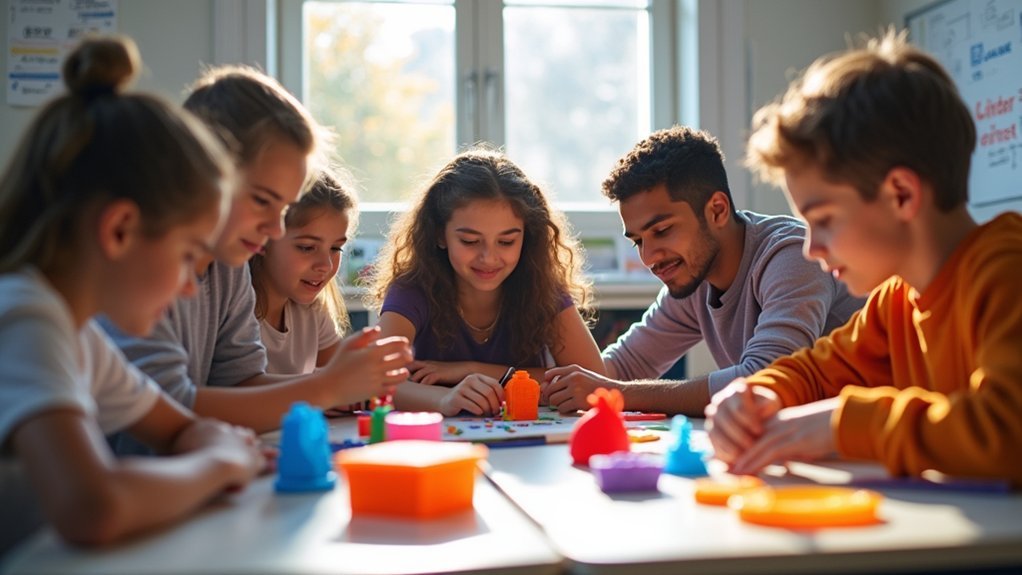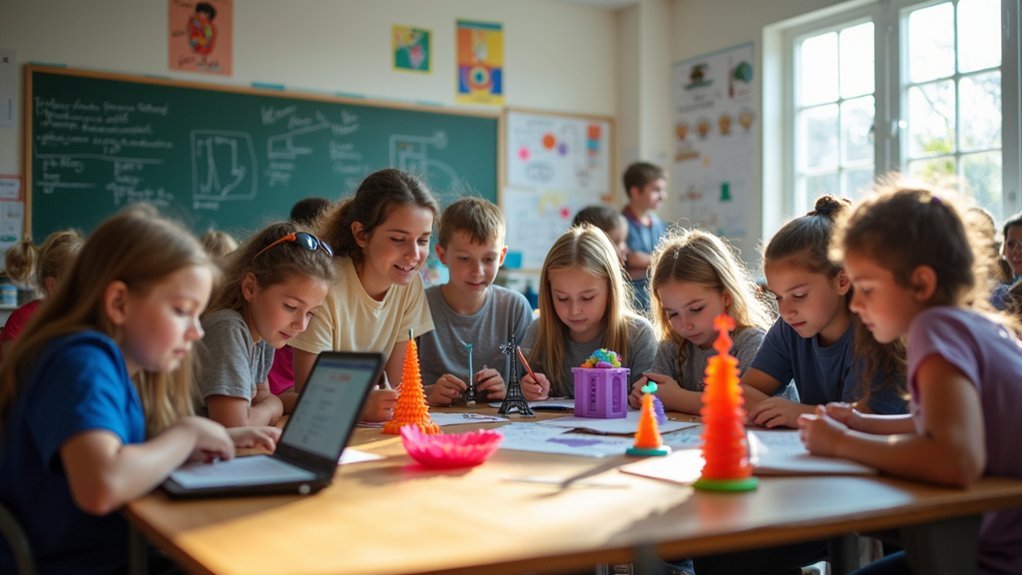You’ll transform your students into innovative problem-solvers by providing 3D printer maker spaces that turn abstract concepts into tangible prototypes. These hands-on environments develop critical thinking through trial-and-error learning while making engineering accessible to all students. Your classroom becomes a dynamic innovation lab where students gain real-world experience with cutting-edge technology, build resilience through design failures, and develop essential collaboration skills that employers desperately seek. Discover how this investment shapes tomorrow’s workforce.
Fostering Innovation Through Hands-On Learning Experiences

When students step into a makerspace equipped with 3D printers, they’re immediately immersed in an environment where abstract concepts transform into tangible reality.
You’ll witness students engaging deeply with the engineering design process as they move from initial sketches to physical prototypes. They’re not just learning theory—they’re testing, iterating, and refining their ideas based on real-world feedback.
This hands-on approach develops critical problem-solving skills through trial-and-error experimentation. Students learn resilience as they navigate design challenges, building persistence when their first attempts don’t work perfectly.
Through trial and error, students build resilience and persistence, developing critical problem-solving skills when designs don’t succeed immediately.
The makerspace environment naturally fosters collaboration, encouraging students to share resources and brainstorm innovative solutions together. You’ll notice increased motivation as learners see their creative concepts materialize into actual products they can hold and examine.
Developing Critical Problem-Solving Skills in Real-World Contexts
Beyond simply creating objects, 3D printer makerspaces transform students into active problem-solvers who tackle authentic challenges that mirror professional environments.
You’ll watch your students develop resilience as they iterate through design failures, learning that setbacks aren’t obstacles but opportunities for refinement. Access to tools enables them to experiment with multiple solutions, analyzing outcomes and adapting strategies based on real feedback.
These collaborative spaces simulate workplace dynamics where you must navigate differing perspectives to reach effective solutions.
When students design assistive devices for individuals with disabilities, they’re not just solving technical problems—they’re developing social responsibility alongside critical thinking skills.
This trial-and-error process builds analytical minds that can break down complex challenges and systematically work toward innovative solutions.
Making Engineering and Manufacturing Accessible to All Students

While traditional engineering and manufacturing can intimidate students with complex machinery and steep learning curves, 3D printing transforms these fields into accessible, push-button experiences that welcome everyone.
You’ll find that printing technology eliminates barriers by using a single filament material to create diverse shapes and sizes, encouraging innovative design without overwhelming complexity.
When you establish makerspaces with 3D printers, you’re creating hands-on opportunities that cultivate STEM interest among all students, regardless of their prior experience.
The iterative nature empowers you to engage in trial-and-error learning, building resilience and problem-solving skills.
Students can explore creative engineering solutions and collaborate on meaningful projects, like designing assistive devices, making engineering relevant and achievable for everyone.
Building Resilience Through Trial-and-Error Learning Processes
Through countless iterations of design, print, and redesign, 3D printing transforms failure from a discouraging endpoint into a stepping stone toward mastery.
Failure becomes fuel for innovation when every print teaches students to iterate, adapt, and ultimately master their craft.
You’ll watch your students develop genuine resilience as they analyze failed prints, identify problems, and adjust their approach. Each prototype becomes a learning opportunity where mistakes aren’t punishments but valuable data points.
This hands-on process builds critical thinking skills you can’t achieve through traditional lectures. When students see their designs come to life, then break or fail to function, they’re motivated to problem-solve and persevere.
The immediate feedback loop of 3D printing creates a safe environment where taking risks feels rewarding rather than threatening. Your students develop the growth mindset they’ll need to tackle real-world engineering challenges throughout their careers.
Connecting Classroom Concepts to Practical Applications

You’ve witnessed how trial-and-error builds resilience, but 3D printing’s true educational power emerges when you connect abstract classroom concepts to tangible, real-world applications.
When you create physical models of mathematical equations or engineer solutions to actual community problems, you’re transforming theoretical knowledge into practical understanding.
This hands-on approach lets you tackle authentic challenges while applying classroom learning in meaningful ways that prepare you for future careers.
Real-World Problem Solving
When students encounter abstract concepts in traditional classrooms, they often struggle to see how these ideas apply beyond textbook pages. 3D printer maker spaces bridge this gap by transforming theoretical knowledge into tangible solutions for real-world problems.
You’ll watch students develop real-world problem solving abilities as they tackle meaningful challenges like designing prosthetic limbs through platforms such as Enabling the Future. These projects directly address societal needs while connecting classroom learning to purposeful outcomes.
Through 3D printing experiences, students develop important skills including critical thinking, teamwork, and communication. They’ll analyze problems systematically, brainstorm innovative solutions, and refine designs based on testing and feedback.
The iterative nature of 3D printing encourages students to adapt and modify their approaches, fostering creativity and persistence when confronting complex challenges that mirror professional engineering and design processes.
Abstract to Tangible Learning
Students often struggle to grasp mathematical formulas, scientific principles, and engineering concepts that remain confined to whiteboards and textbooks.
3D printer maker spaces transform these abstract ideas into physical objects students can hold, examine, and test. When you’re learning about molecular structures, geometric shapes, or architectural designs, the printing process brings these concepts to life in ways traditional methods can’t match.
You’ll see students suddenly understand complex theories when they can manipulate physical models they’ve created themselves. This hands-on approach bridges the gap between theoretical knowledge and practical application, making lessons more engaging and memorable.
The transformation from digital design to tangible prototype reinforces learning through multiple senses, creating deeper comprehension and lasting educational impact.
Preparing Students for Future STEM Careers and Technologies
You’re positioning your students at the forefront of tomorrow’s workforce when you integrate 3D printing maker spaces into their educational experience.
These hands-on environments expose them to cutting-edge technologies that mirror what they’ll encounter in rapidly expanding STEM industries, from aerospace engineering to biomedical device development.
You’re not just teaching concepts—you’re building the critical thinking, problem-solving, and technical skills that employers actively seek in the next generation of innovators.
Real-World Industry Preparation
As today’s industries increasingly rely on digital fabrication and rapid prototyping, 3D printer maker spaces in schools bridge the gap between classroom learning and real-world STEM careers.
When you provide students access to printing technology, you’re exposing them to the same tools engineers and architects use daily. They’ll master CAD software and understand manufacturing processes that drive modern innovation.
You’ll watch students develop critical problem-solving abilities as they iterate designs and troubleshoot technical challenges. These collaborative projects mirror actual workplace dynamics, teaching communication and teamwork skills essential in STEM fields.
Advanced Technology Exposure
Beyond workplace readiness, 3D printer maker spaces immerse students in cutting-edge technologies that’ll define tomorrow’s innovation landscape.
This advanced technology exposure equips you with essential digital fabrication skills that’re becoming standard across STEM industries. When students interact with sophisticated design software and manufacturing processes, they’re not just learning tools—they’re developing technological fluency that positions them ahead of their peers.
- Digital Design Mastery: Students gain proficiency in CAD software and 3D modeling programs used throughout engineering and design industries.
- Manufacturing Process Understanding: Hands-on experience with additive manufacturing teaches students how digital concepts translate into physical products.
- Innovation Mindset Development: Working with advanced technologies fosters creative problem-solving approaches that drive technological breakthroughs.
This exposure greatly increases students’ likelihood of pursuing STEM degrees and careers.
Career Pathway Development
When students engage with 3D printer maker spaces, they’re building direct pathways into tomorrow’s fastest-growing career fields. You’re giving them access to essential tools and resources that directly prepare them for STEM careers projected to grow 8% through 2029. These hands-on experiences develop critical technical skills employers desperately need, including CAD software proficiency and advanced problem-solving abilities.
| Career Field | Skills Developed |
|---|---|
| Biomedical Engineering | Prosthetics design, medical modeling |
| Advanced Manufacturing | CAD proficiency, production optimization |
| Sustainable Design | Eco-friendly product development |
| Robotics Engineering | Component fabrication, prototyping |
| Product Development | Real-world problem solving |
You’re preparing students for emerging fields where 70% of employers seek candidates with both technical expertise and collaboration skills. Through tangible project creation, students understand how technology addresses societal challenges, making them highly attractive to future STEM employers.
Cost-Effective Implementation and Sustainable Resource Management
While traditional school workshops require extensive inventories of materials and tools, 3D printer makerspaces offer a streamlined approach that transforms how you’ll manage educational resources.
You’ll discover that 3D printing technology minimizes waste by using only necessary filament amounts, creating budget-friendly options for your institution. The initial investment leads to long-term savings through versatile design capabilities without requiring extensive additional equipment.
- Reduced Material Costs: You’ll eliminate the need for multiple materials and parts while promoting sustainability through efficient resource utilization.
- Simplified Operations: 3DPrinterOS streamlines management of multiple printers, reducing logistical challenges across various machines.
- Sustainable Practices: Your makerspace will align educational goals with cost-effective solutions that encourage environmentally responsible project development.
Encouraging Collaborative Learning and Community Engagement
Since 3D printer makerspaces naturally bring students together around shared technology and creative challenges, you’ll find these environments become catalysts for collaborative learning that extends far beyond traditional classroom boundaries.
When you establish a makerspace, you’re creating opportunities for students to develop essential teamwork and communication skills through group projects that mirror real-world problem-solving scenarios.
You’ll witness community engagement flourish as students design assistive devices for individuals with disabilities, directly impacting local lives while applying their technical skills.
These spaces connect your students with local organizations and businesses, creating partnerships that provide authentic learning contexts. The shared resources foster ownership and belonging, while regular workshops attract community members, bridging gaps between your school and local stakeholders through meaningful knowledge sharing.
Managing Multiple 3D Printers in Educational Environments
You’ll quickly discover that managing multiple 3D printers with different interfaces and software creates workflow chaos in your educational makerspace.
When students can’t efficiently access printers or track their jobs, frustration builds and learning opportunities diminish.
That’s why implementing a unified platform becomes essential for streamlining operations and maximizing your makerspace’s educational impact.
Streamlined Workflow Solutions
Although educational institutions often struggle with the complexity of managing multiple 3D printer brands and their disparate software systems, implementing unified platform solutions can transform chaotic workflows into streamlined operations.
You’ll find that centralized management tools like 3DPrinterOS eliminate the frustration of switching between different interfaces and protocols.
These streamlined workflow solutions offer significant advantages:
- Reduced downtime – Smart slicer features minimize print failures and maintain consistent results across all machines
- Enhanced accessibility – More students can access equipment simultaneously, maximizing your makerspace resources
- Simplified maintenance – Unified protocols reduce technical troubleshooting time
When you implement these tools, your educators can focus on teaching instead of managing technical issues, creating a more productive learning environment where students engage in meaningful, innovative projects.
Unified Platform Benefits
Managing multiple 3D printers from different manufacturers creates a complex web of software interfaces, file formats, and operational protocols that can overwhelm even experienced educators.
You’ll find that platforms like 3DPrinterOS eliminate this chaos by providing a single interface for operating different brands and models simultaneously. Instead of juggling various software systems, you can focus on what matters most—guiding students through creative projects and innovations.
Smart slicers automatically optimize designs for each printer, dramatically reducing failed prints and boosting success rates.
Your university makerspace transforms into a collaborative hub where students spend time creating rather than troubleshooting technical issues. This streamlined approach enables seamless curriculum integration across subjects, maximizing your 3D printing resources while maintaining consistent access for all students.
Transforming Abstract Ideas Into Tangible Prototypes
When students transform abstract concepts into physical objects through 3D printing, they bridge the gap between theoretical knowledge and practical understanding.
You’ll watch as complex physics and engineering principles become tangible, making challenging subjects suddenly accessible and engaging.
Transforming abstract ideas into tangible prototypes revolutionizes how you’ll approach learning. The iterative design process naturally develops critical thinking and problem-solving skills as you test, analyze, and refine your creations based on real-world feedback.
- Enhanced visualization: Complex mathematical formulas and scientific principles become concrete objects you can touch and manipulate.
- Improved retention: Physical interaction with your designs creates lasting memories that traditional textbook learning can’t match.
- Boosted creativity: The freedom to prototype encourages innovative thinking and experimentation without fear of failure.
Supporting Cross-Curricular Learning Across Academic Disciplines
As 3D printer maker spaces break down traditional subject barriers, you’ll discover how mathematics seamlessly connects with art, science merges with history, and engineering principles enhance language arts projects.
Your students won’t just learn isolated facts—they’ll experience cross-curricular learning that transforms how they understand interconnected knowledge.
When students design prototypes for science experiments or create artistic sculptures, they’re applying mathematical calculations, artistic principles, and scientific concepts simultaneously.
You’ll witness collaboration between students from different disciplines, developing essential teamwork and communication skills they’ll need beyond school walls.
High school students can tackle meaningful interdisciplinary projects like developing assistive devices, combining engineering design with ethics and health sciences.
This hands-on approach encourages critical thinking and innovation, preparing your students for complex real-world challenges.
Enabling Student-Led Innovation and Creative Problem-Solving
Since students gain access to 3D printer maker spaces, they don’t consume knowledge—they create it. You’ll witness student-led innovation flourish as learners take ownership of their educational journey, designing and prototyping solutions that reflect their unique perspectives and interests.
These spaces transform students into confident problem-solvers who embrace challenges through hands-on experimentation. They’ll develop critical thinking skills by tackling real-world problems, learning from failures, and iterating until they achieve success. The engineering design cycle becomes second nature as theoretical concepts merge with practical application.
- Students collaborate naturally, sharing ideas and learning from peers’ diverse approaches.
- Trial-and-error processes build resilience and creative thinking capabilities.
- Self-directed projects increase motivation and investment in learning outcomes.
You’ll see engagement soar when students pursue passion-driven projects that matter to them personally.
Building 21st-Century Skills for Tomorrow’s Workforce
While students explore and create through 3D printer maker spaces, they’re simultaneously developing the essential skills that tomorrow’s employers desperately need.
You’ll find that 3D printing provides students with hands-on experience in digital design, engineering, and manufacturing—competencies that directly translate to careers in rapidly evolving industries.
Through iterative design processes, you’re cultivating critical thinking and problem-solving abilities that enable adaptation to future workforce challenges.
Collaborative projects foster teamwork and communication skills vital for workplace success.
Students transform ideas into tangible products, developing entrepreneurial capabilities important in today’s innovation-driven economy.
This exposure to advanced technology builds the adaptability needed to navigate the ever-changing 21st-century job market, ensuring graduates thrive in tomorrow’s workforce.
Frequently Asked Questions
What Is the Point of a 3D Printer Enclosure?
You’ll get better print quality with consistent temperatures that reduce warping. The enclosure protects from dust, contains fumes for safety, reduces noise levels, and improves energy efficiency by minimizing heat loss.
What Are the Benefits of 3D Printing in Education?
You’ll develop problem-solving skills through hands-on design and testing. 3D printing enhances your creativity, connects theoretical concepts to real-world applications, and prepares you for STEM careers while making learning more engaging and relevant.
What Is the Purpose of Makerspaces?
You’ll find makerspaces provide collaborative environments for hands-on learning and creative design. They foster teamwork, problem-solving skills, and experimentation while giving you access to tools that transform abstract ideas into tangible prototypes.
What Are the Benefits of 3D Printing in Space?
You’ll reduce launch costs and cargo weight by printing tools on-demand. You can create replacement parts during missions, adapt to unexpected challenges, and develop stronger materials in microgravity for future space exploration.





Leave a Reply